This presentation was delivered at 2022’s Product Marketing Summit in Austin. Catch up with a variety of talks with our OnDemand service.
I started my career as a quota-carrying sales rep, and like many PMMs, I fell into product marketing. But when I say “fell,” I quite literally mean fell.
Back in BC – before COVID – I was in the office kitchen, and my phone rang. I had finally gotten in touch with the CMO that I had been going after. I turned around and started running to my desk, and ran straight into someone else – the Director of Product Marketing.
As an apology, I took him out to coffee, and our friendship began. That's how I realized that I was in the wrong career; everything he said about what he does day to day was exactly what I wanted to do, so I started transitioning into product marketing.
From there, I became a solo PMM in a product organization. As you can imagine, half of my days were spent trying to explain to my boss that I was not a product manager and that my job was to write user stories and build product messaging and positioning, and that, no, those aren't the same thing.
Now, I lead product marketing for Rev’s developer platform, and I am full stack if you will. I deal with everything from Go-to-Market strategy to sales enablement to competitive and market intelligence. Today, when I talk about enablement, it's from the lens of both a rep and a product marketer.
I’m going to address a few areas of discussion, including:
- The challenges of sales enablement for product marketers
- Why most enablement misses the mark
- How to know your seller personas
- Enablement versus execution
- The three Rs framework for success
“Yes, but…”
I know we've all been in this position – you’re in the zone, you're focused, you’re deep into your messaging and positioning for an upcoming product launch coming up, and all of a sudden you get a Slack message
It's from a rep. They’re saying, “I have the biggest deal. It's the best thing ever. It's going to be game-changing for our company. And by the way, I need you to drop everything and make a bespoke deck. Our existing messaging won't work for this client; they don't care about anything we have today. Can you help me?”
And you're thinking, “Well, what do I do? I have this product launch coming up. I’ve got to crank out this messaging and positioning. Do I help this person?” The answer is “Yes, but...” and the “but” is critical here.
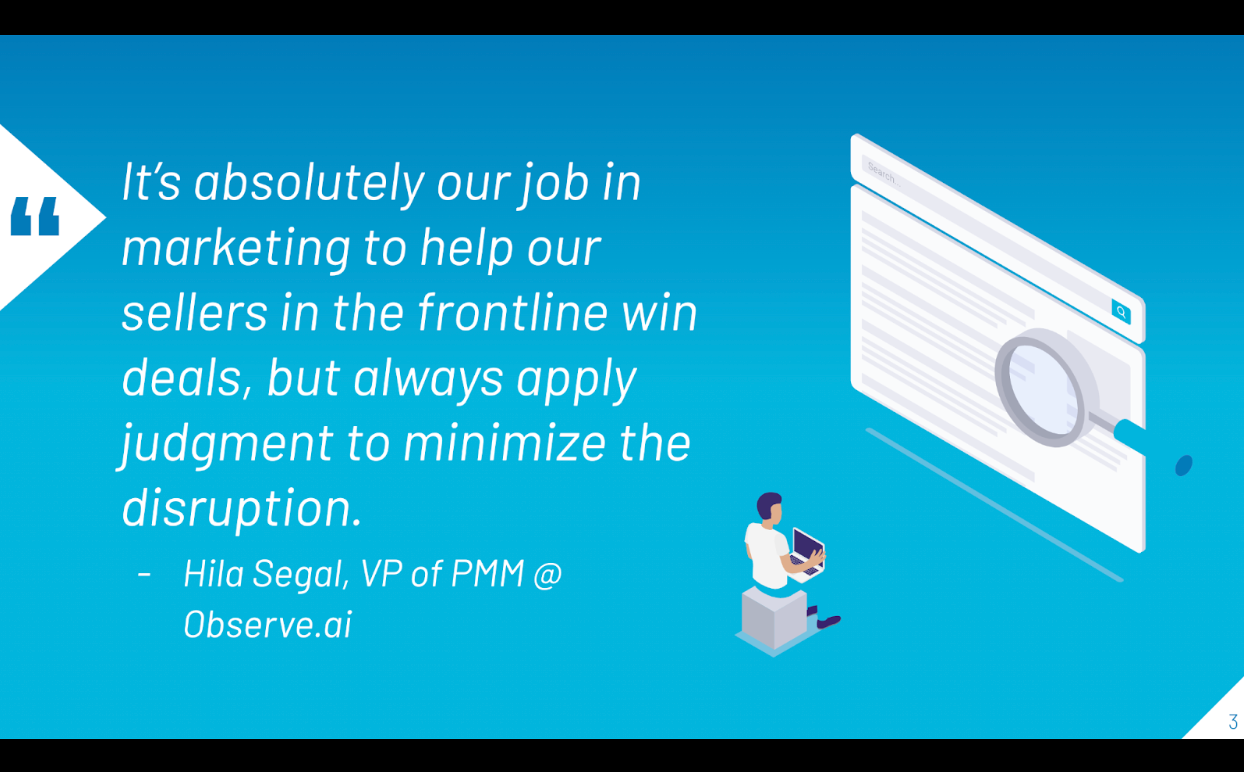
Let's ask some qualifying questions. Is it maybe an education problem? Have you already created something they don't know about that could be repurposed for this situation? Is there another rep that has closed a similar deal that you can introduce into this conversation so you can get back to your messaging and positioning?
If all of the above is no, then you go in and help, but be intentional with your efforts here. Think about how what you’re doing today is going to help the rest of the sales team. What are you going to do to make sure this is just a single request, and the next time the team can self-service?
The challenges of sales enablement for product marketers
It's not just about prioritization; enablement is hard for a lot of different reasons. Number one is the question of where to even begin. What's the right content to start with? Do we just need one-pagers? Should I be making pitch decks all day?
More importantly, should I be doing all of this? Is there someone in product or elsewhere in the organization that should be responsible for some of these things? And then finally, how do I know any of this is even working? Are the people that I'm making this for actually using all of this content?
I’m willing to bet that most product marketers have asked themselves these questions in the last 30 days. It happens all the time. This is why sales enablement is so challenging for us as product marketers.
The key to success, in my mind, is to remember that salespeople don't just do what you expect, but they will do what you inspect. We need to share the burden of content generation and adoption. Your product marketing team should not be the only team responsible; you need to align with the rest of your counterparts in sales leadership.
That way, we're all working together to make sure we have the right materials, and everyone's working on the high-value tasks that are going to help the organization hit its revenue goals.
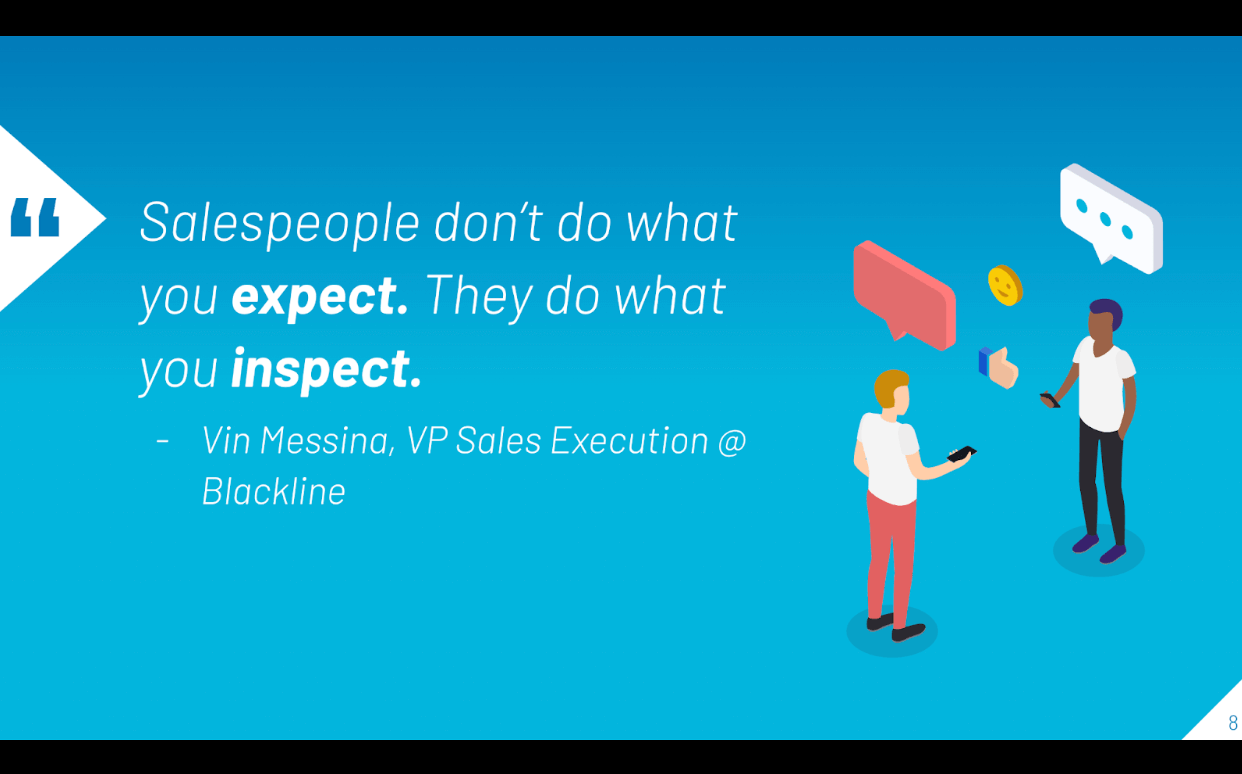
Why most sales enablement misses the mark
But let's get a little bit more specific. What are some of the common mistakes that teams make with sales enablement?
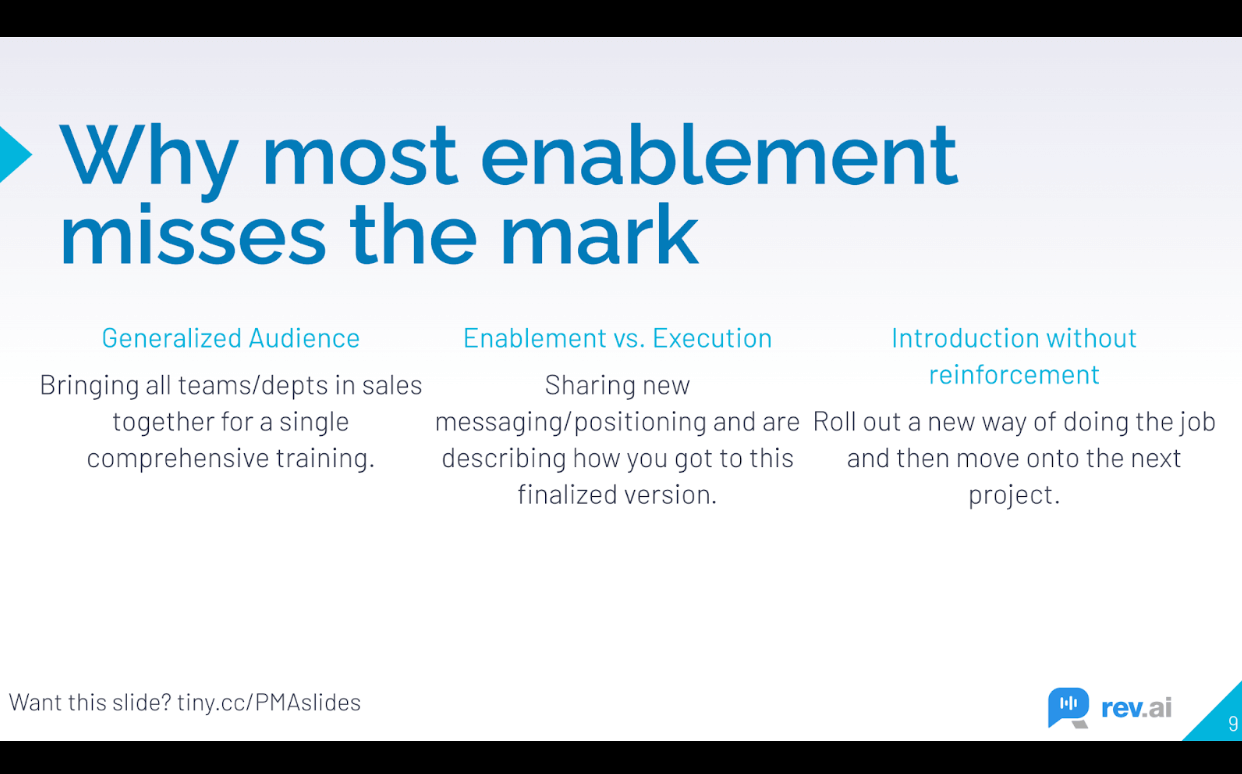
1) Having a highly generalized audience
As product marketers, we know that you can either be something for someone or you can be nothing for everyone. The world of everything for everyone simply does not exist. So why is your enablement any different?
What your Sales Development Representative needs is not the same as what your Mid-Market Account Executive needs. What your strategic sellers need is totally different from what your post-sale team needs. Your technical teams, like your solutions engineers or your implementation teams, are going to have wildly different needs again. If you want to meet each team’s needs, you need to individually tailor to them.
2) Focusing solely on enablement and not thinking enough about the execution
Our job as product marketers is to take the guesswork out of sales. That means not just having information about the buyer and the messaging and positioning, but also the best way to reach that buyer.
We do this today with our demand gen counterparts. We build a beautiful foundation, and then we lean on their expertise for the right channels and tactics to leverage to make sure that our message is meeting the buyer where they're at. Our sales counterparts are looking for the same type of tactical advice from us.
3) Having no opportunity to practice
This might be a familiar scenario: you're listening to sellers’ conversations through Gong or Chorus, and you're hearing those cringe moments where a rep is trying to pitch your solution or position against a competitor, and you're like, “Oh no. We need better sellers.” You chalk it up to having bad sellers or needing to fix your sales training and onboarding.
But for a moment, think about the alternative.
You've come in and you've shown the rep the Promised Land. You’ve said, “Here's this great messaging, here's this great positioning, and here's this awesome pitch deck that is going to help you win every single deal,” but where's the opportunity for them to practice what you want them to start saying? The reality is we're all humans at the end of the day, and as humans, no one wants to look dumb.
When you're on the call, those cringe moments that you're hearing are coming from the sellers that are trying to adopt the new messaging but haven’t had an opportunity to practice. The sellers that are really worried about looking dumb are the ones who are defaulting back to their old pitch – that’s what they know and what they feel confident in.
In the meantime, you’ve already moved on. You're back to your positioning document, trying to get ready for that next tier-one launch, but this is what's happening with the reps. Let's break down some strategies to help them, so we can get over these sales enablement hurdles together.
How to know your seller personas
Understanding personas is what we do all day, and we can apply this tactic to our sellers too. You're most likely gonna encounter three types of sellers in pretty much every sales department.
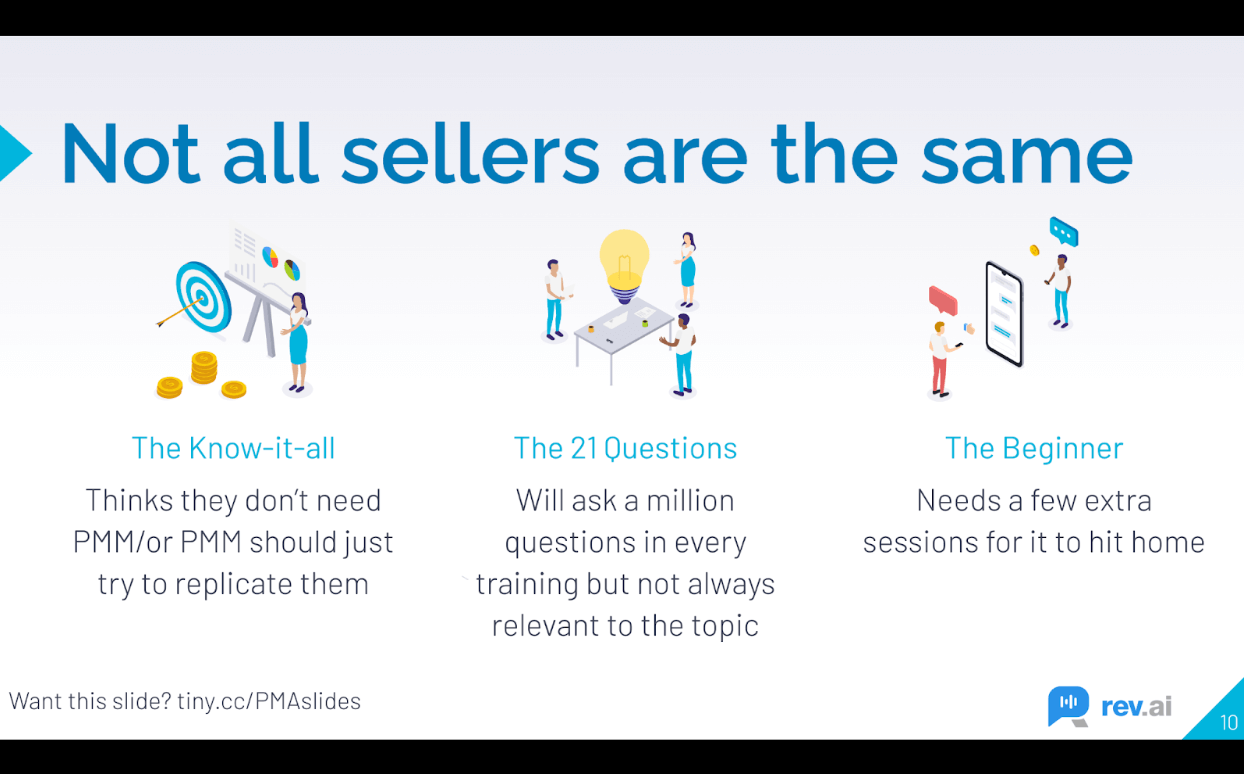
1) The know-it-all
We all know them. The know-it-all is the person who believes that they don’t need a product marketer to be able to do their job, or, if a product marketer has to get involved, they should be trying to replicate what the sales rep is already doing because it’s just so magical.
These are the people that you want to spend time with one-on-one and early on. Don't come with them with any plan; just ask them questions to leverage their experience. Your job is to prove to them that you can build a repeatable framework based on what they're doing.
2) The 21 questions
I know you know who I'm talking about. This persona always has a bunch of questions, and there's a great way to leverage them.
When you get a little bit more meat on your plan – maybe you have a rough outline of what you want to cover or some key learning outcomes – that's when you want to take your plans to the 21 questions, but you want to partner with your sales managers or your enablement counterparts.
Your sales manager or enablement partner is there to gut-check whether the questions they're asking are representative of the broader sales team. Some of those questions are going to be irrelevant and will not need to be answered in your enablement content.
3) The beginner
They’re brand new to sales and just getting the hang of things, and that's okay. This is where your partnership with sales management and your enablement counterparts is critical.
The beginner is going to need more love. You can't just introduce a new concept – they're not going to pick it up immediately. Partner with your sales management and enablement team to build a plan for how to show some extra love before you get into the enablement session.
Share all your materials with the beginners in advance, so they have a chance to proactively read and digest them.
After the session, make sure you send a recap of the key takeaways. You should have a plan in place with your sales managers to ensure that information is consistently reinforced so it gets absorbed. Then you can collectively focus on those behavioral changes.
Enablement versus execution
A lot of product marketers talk about what to say, but we don't talk about how to say it. Often, the issue is that sellers aren’t sure at what point in the conversation they should bring something up.
Let's take a case study, for example. You have these brilliant case studies that you worked on for weeks. They show great ROI, they have crystal-clear messaging, and you're super proud of your work. Your sellers are still going to have questions.
In my workflow, is this something that I include in the first touch? Do I wait until I get an objection from a buyer and then send in my case study? Do I just attach this to every single email and wait for my response rate to go up? They need to understand the how.
A lot of these questions are often left unanswered, and then you're scratching your head saying, “Why the hell aren't they using the content?” It's because you haven't explained how. That's the difference between good enablement and fantastic enablement.
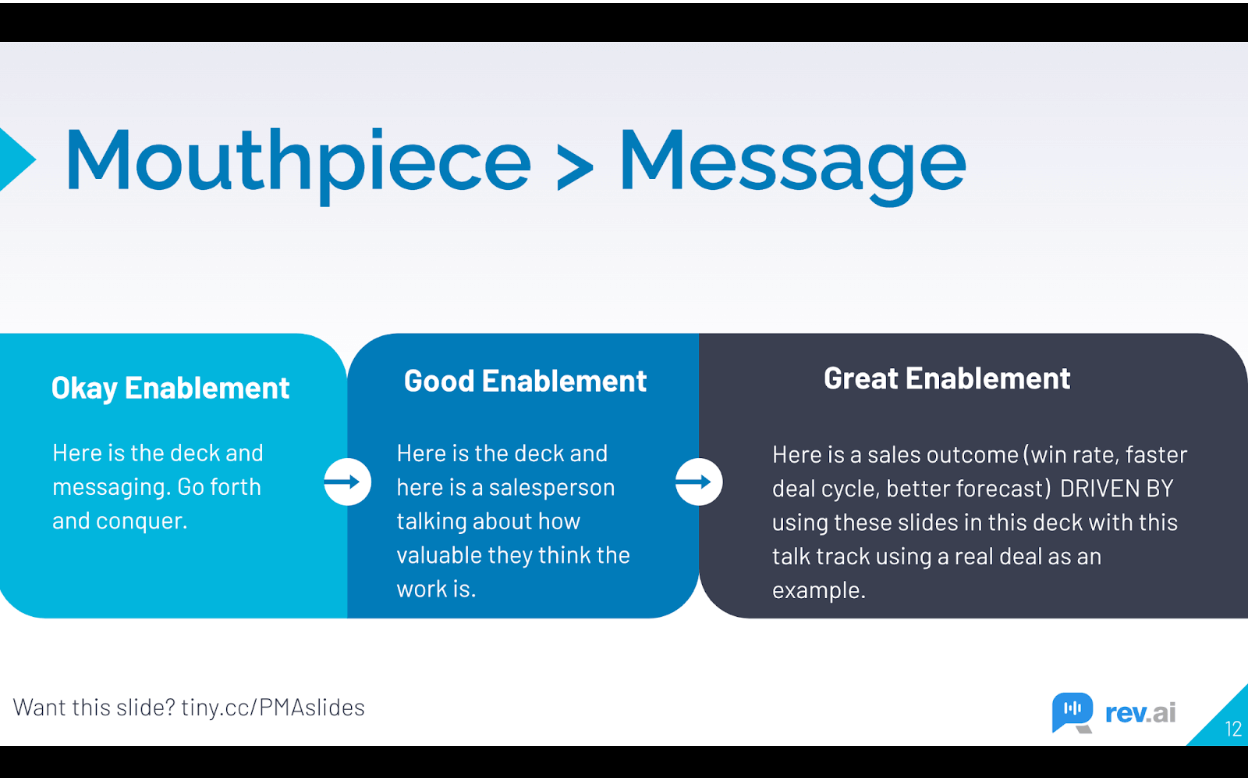
To start building fantastic enablement, we should be thinking about workshops instead of just presentations. At Rev, we already do this today with our product launches, especially when we have something that's early into the market and we're not super confident about going to market.
We have a beta to work out the kinks, and then we find early adopters who are having a great experience with the product. We take their message and we amplify it. When we go to general access, we're leading from the front with all these customer stories, saying “Look at how great this thing is.”
Why is your enablement any different? Before you go into any team-wide discussion, you should be dogfooding your enablement with your sellers. It's not just to get feedback; it's to run pilots. That way, by the time you get to the full team, sellers can present on your behalf if they feel confident enough.
You're not just presenting updates; you're presenting outcomes. You're saying, “Look at this big deal they just won.” “Look how we won a deal over that competitor that everyone is struggling with.”
Then you can ask those early-doors sellers what collateral and content they used to make that happen, how they incorporated the pitch into their workflow, and what resonated.
The three Rs framework for success
Every good product marketer has a framework. We’re all building systematic ways to repeat success in our organizations. I think about the three Rs as a measure of success.
1) Retention
You may already be doing a check for understanding, but how often are you checking for retention? The difference between understanding and retention is behavior change. One to two weeks or a month after you've introduced all this great new stuff, how many people have shifted their behavior?
2) Repetition
This goes back to what I was saying earlier about salespeople doing what you inspect rather than what you expect. Your sellers’ managers should be asking questions after every single call. How did it go? Do you think it'll close this quarter? Do you need anything else from me?
That's a great opportunity for you to piggyback and expand the types of questions they're asking. For example, is there any content or collateral that’s missing right now? Can we get product marketing's help to figure out the right place to incorporate that content?
3) Research
In the worst situation, where you don't have retention or repetition, it’s time to fall back on plain old research.
You may have your dossier on your competitors, with three pages on their messaging and positioning, Go-to-Market strategy, focus industries and verticals, and pricing. However, the reality is that that doesn't fit into the workflow.
Let's say I'm a rep on a call with a prospect, and they say, “I'm thinking about X competitor.” In my brain, I go, “Oh, dear,” and I start furiously typing and trawling through this three-page dossier while I'm still on the call.
Now, I'm not trying to close a deal. The whole point of a sales conversation is to get to the next conversation. That's it. I don't need a three-page dossier. I'm looking for one or two key points, topics, or questions that will get this person to allow me to present in-depth how we're different from this competitor. But first, I have to earn that slot on their calendar.
If I have to scroll through three pages of information, trying to find those two or three points, you better believe we’re going to struggle with adoption. That's where sellers start making stuff up and saying whatever they have to, to move the conversation forward.
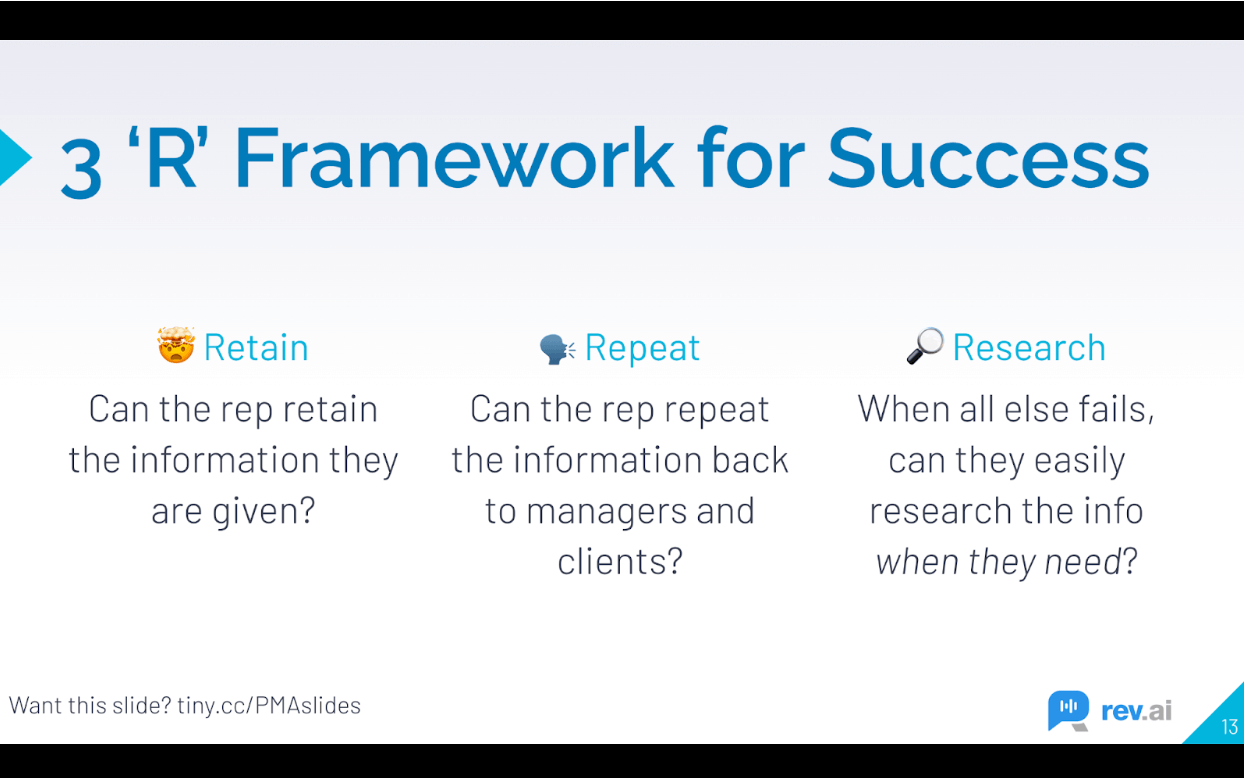
I've used this framework for years. I feel super confident that if your goal is to stop working on tactics all day and start focusing on strategic projects, or if your goal is to be a trusted partner for sellers, this framework will help you.
Start talking about it with your sales managers and enablement counterparts. That's how you become a trusted partner instead of a content-generating machine. At the same time, you'll start to see a clear line between the work that you're doing on enablement and your win rates and pipeline goals.


















 Follow us on LinkedIn
Follow us on LinkedIn



.svg?v=85af970283)